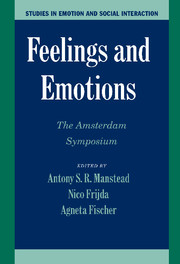Book contents
- Frontmatter
- Contents
- List of Contributors
- 1 Introduction
- PART I THE NATURE OF FEELINGS AND EMOTIONS
- PART II BASIC PSYCHOLOGICAL PROCESSES IN FEELINGS AND EMOTIONS
- PART III FEELINGS AND EMOTIONS: THE PLACE OF PLEASURE
- PART IV FEELINGS AND EMOTIONS IN THEIR SOCIOCULTURAL CONTEXT
- PART V FEELINGS, EMOTIONS, AND MORALITY
- 22 On the Possibility of Animal Empathy
- 23 Emotional Gifts and “You First” Micropolitics
- 24 Introducing Moral Emotions into Models of Rational Choice
- 25 Virtue and Emotional Demeanor
- 26 Epilogue
- Subject Index
- Author Index
- Plate section
- References
24 - Introducing Moral Emotions into Models of Rational Choice
Published online by Cambridge University Press: 05 June 2012
- Frontmatter
- Contents
- List of Contributors
- 1 Introduction
- PART I THE NATURE OF FEELINGS AND EMOTIONS
- PART II BASIC PSYCHOLOGICAL PROCESSES IN FEELINGS AND EMOTIONS
- PART III FEELINGS AND EMOTIONS: THE PLACE OF PLEASURE
- PART IV FEELINGS AND EMOTIONS IN THEIR SOCIOCULTURAL CONTEXT
- PART V FEELINGS, EMOTIONS, AND MORALITY
- 22 On the Possibility of Animal Empathy
- 23 Emotional Gifts and “You First” Micropolitics
- 24 Introducing Moral Emotions into Models of Rational Choice
- 25 Virtue and Emotional Demeanor
- 26 Epilogue
- Subject Index
- Author Index
- Plate section
- References
Summary
ABSTRACT
Traditional rational choice theorists view the moral emotions as obstacles to the pursuit of narrow self-interest. This paper challenges this view. Drawing on evidence that moral emotions facilitate mutual cooperation in social dilemmas, it suggests they are not only consistent with, but perhaps even necessary for, the pursuit of self-interest.
Traditional rational choice models ignore the emotions. When rational choice theorists do speak of them, usually it is to characterize them as obstacles to the pursuit of self-interest (see, e.g., Hirschman, 1997). Modern neuroscientists offer a different view. Damasio and others, for example, have observed that, although patients with lesions in the emotional centers of the brain are typically able to make complex rational calculations, they often cannot focus on the most pressing tasks at hand (Damasio, 1995). In Damasio's account, the emotions promote self-interest by making people more likely to apply their cognitive capacities where they will do the most good. In this sense, his account is in harmony with functional accounts of human behavior that originate in rational choice theory. Each assumes that behavior is molded by the imperatives of narrow self-interest.
But there are also other ways in which the emotions – in particular, the moral emotions – lead us to abandon narrow self-interest. We leave tips at out-of-town restaurants we will never visit again. We donate bone marrow in an effort to save the lives of perfect strangers. We find wallets and return them with the cash intact. We vote in presidential elections.
- Type
- Chapter
- Information
- Feelings and EmotionsThe Amsterdam Symposium, pp. 422 - 440Publisher: Cambridge University PressPrint publication year: 2004
References
- 26
- Cited by



